p a i n t i n g
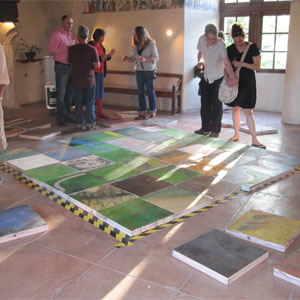
To visualise humans as part of nature
and in relationship with non-human species
I paint using a birds eye view instead of the traditional European frame.
Some paintings are participatory, like the one shown here.
'Life in the Age of Covid'
where the bodies are buried ; the field ; when the world stood still
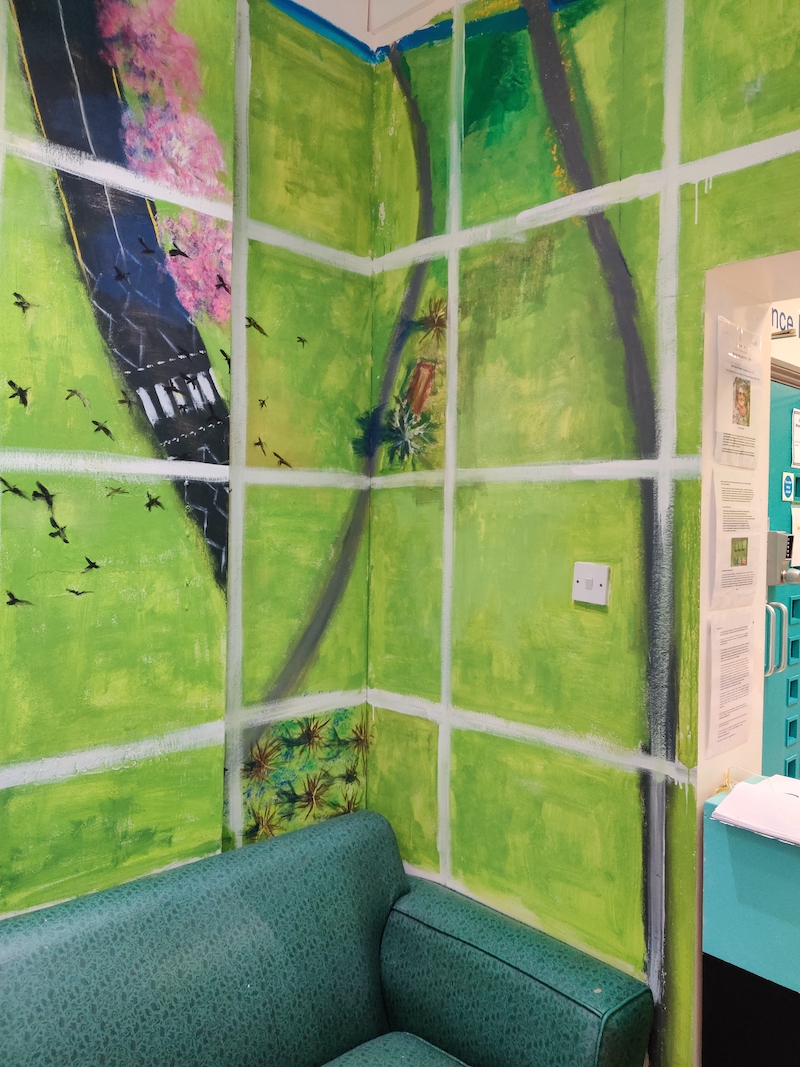
eco-friendly Lakeland paint on walls
total dimensions of site specific painting approx 4m x 25m

Lucinda Sieger, Ann Froggatt, Jason Atmann, David Napier
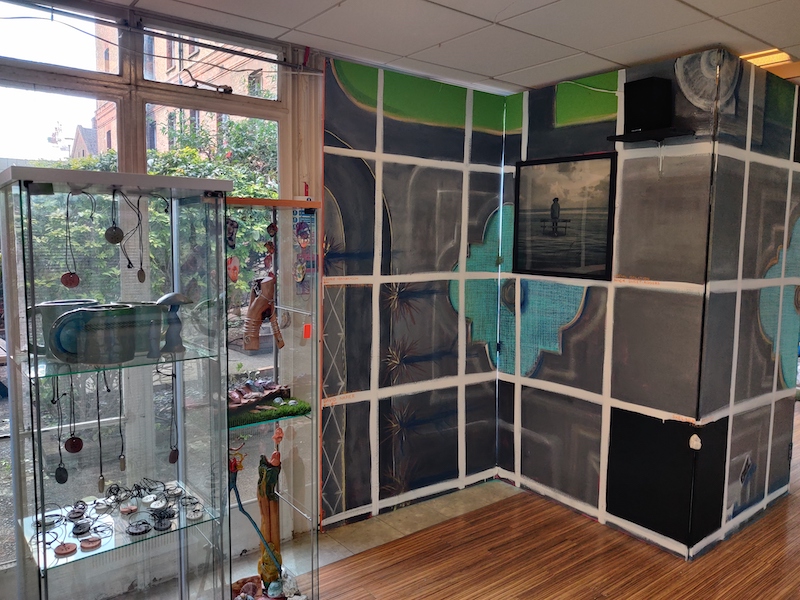
Installation view
with vitrines by Leonie Abrahamson and David Napier and digital image by Nicholas Sweet-Rogers
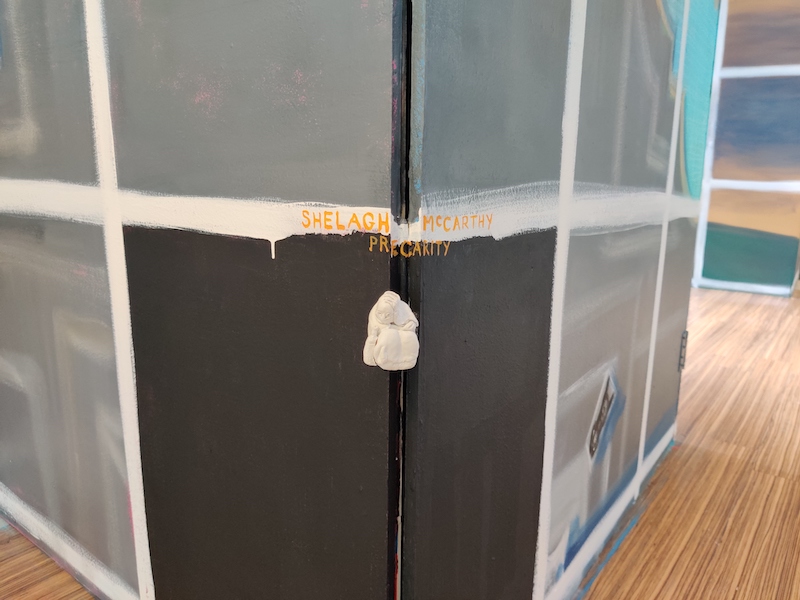
Site-specific and participatory commission for The Arts Project, NHS St Pancras Hospital 2022
Sounds of the lockdown dawn chorus recorded by Rob Godman
Rebecca Deary 'Fridge' (left) and Charlotte Harker 'Mask' (bottom right)

Participants included professional artists, amateur artists, non-artists, service users, children, art students and others, highlighting the wide-ranging impact of lockdown on us all:
Leonie Abrahamson, Irene Akwuba, Jason Atmann, Lorenzo Belenguer, Rebecca Deary, Ann Froggatt, Julie Goodman, Marion Hack, Charlotte Harker, Peter Herbert, Shelagh McCarthy, Claire McDermott, Ignazio Miranda, Luke Morgan, David Napier, William Newbronner, Robyn Parker, Alexandre Santacruz, Jessica Scott, Lucinda Sieger, Nicholas Sweet-Rogers, Roxanne Williams, with the dawn chorus recorded by composer, Rob Godman.
Vimeo Video maker Anna Bowman responded to the Life in the Time of Covid with this film
https://vimeo.com/753514018

acrylic and oil on canvas
dimensions 172 x 470cm
(curated by Elizabeth Murton for UHArts)
Launch of Art Sci Lab at University of Hertfordshire
This small series of paintings comes out of another project in 2019 with Leeds Art Gallery as part of the Yorkshire Sculpture International, called Woodworm.
Where the Bodies are Buried uses the responses of participants to the anthropological collections of Leeds, as the basis for these paintings. Sculpted and gouged plywood are the ground, the foundation, for the paintings.
But it is also inspired by 2020's Black Lives Matter movement, which started in the USA with the unlawful police killing of George Floyd. This sparked a global movement, including in Britain and Australia.
In Australia, the statistics for police brutality of Aboriginal people are even more shocking than the unlawful killing of African Americans at police hands.
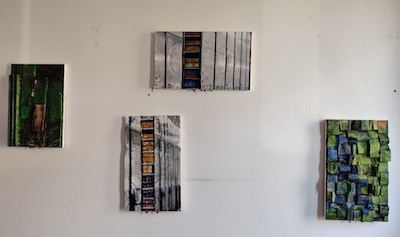

- I imagine 3 of the 4 paintings as a triptych, inspired by the idea of tavolette - portable religious paintings held before the eyes of the condemned as they made their way to the place of execution used in Italy during the Renaissance.
- The three panels would be hinged, similar to a traditional vanity table.

- All 4 of these paintings have the same title:
Where the Bodies are Buried - This is the left hand side of an imagined triptych
The painting is a birds eye view of Meath Gardens in London. It used to be a cemetery called Victoria Park Cemetery when it opened in 1845 as a cemetery for the poor. It closed in 1876. It is estimated that 300,000 bodies were laid to rest there the vast majority of which were children (75%).
This view is one of the few existing memorials in the garden and it is the grave of Australian Aboriginal cricketer, Bripumyarrimin or 'King Cole' who dies in 1868 after the first ever tour of Australian cricketers to England. It was the first and only all-Aboriginal team.
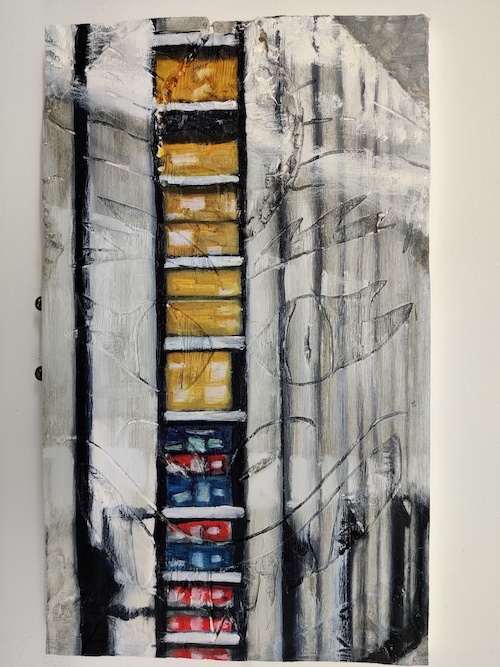
- This is the middle panel of an imagined triptych
The painting is of the folk and anthropology artefact storage facility for Leeds Museums.

- This is the right hand side of an imagined triptych
The painting is a birds eye view of the Royal Botanical Gardens in Melbourne, Australia. The land is Kulin nation country and had always been rich in indigenous biodiversity and significance for the Koori people prior to becoming a botanical garden in 1846.
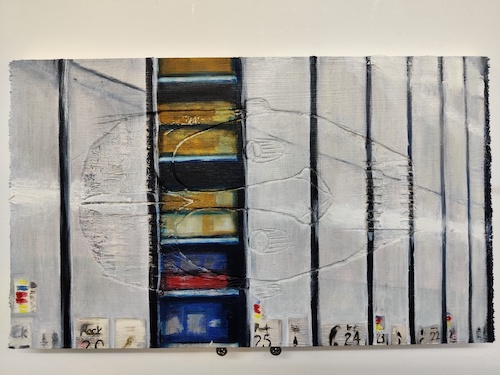
It might be used as the middle panel.
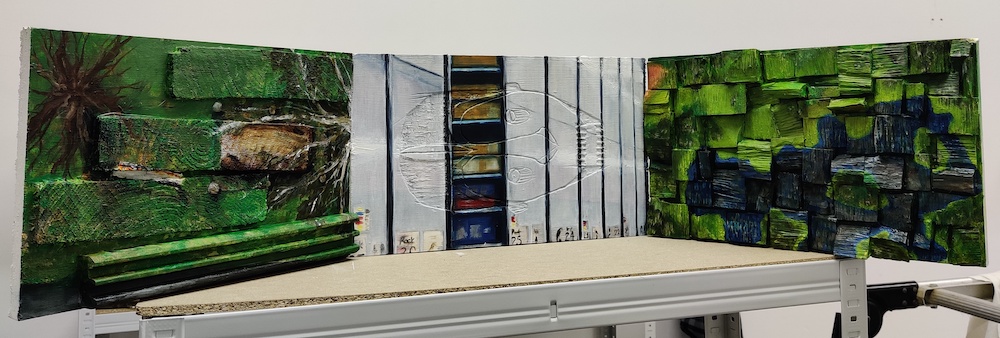
I think this painting experiment works best this way.
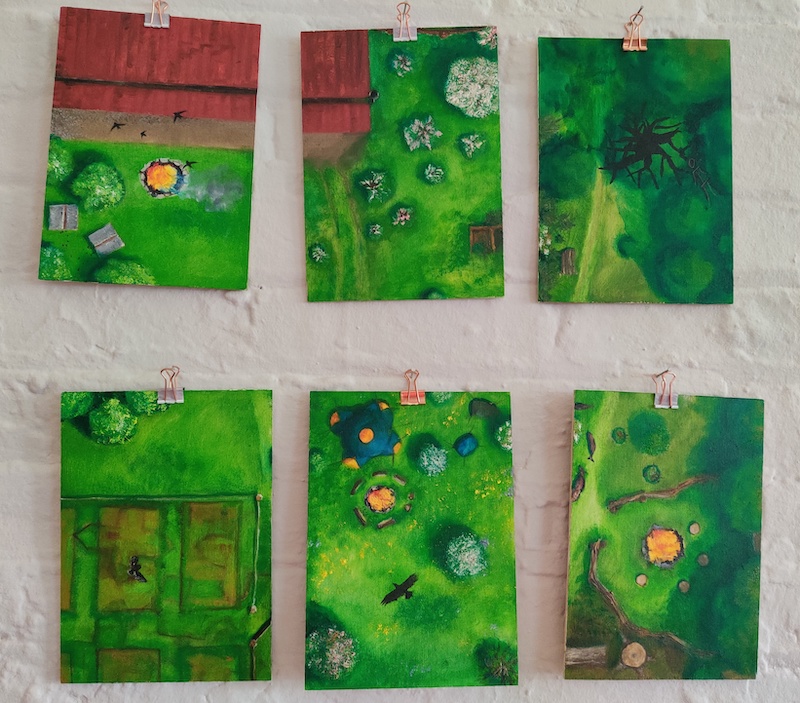
This was the first painting I made for 15 years. Each wooden panel is 22cm x 16cm. It is a birds eye view from memory, of memories, of The Field.
The Field was a site for art and an artwork in its own right that operated from 2009-2017, when it was sold.
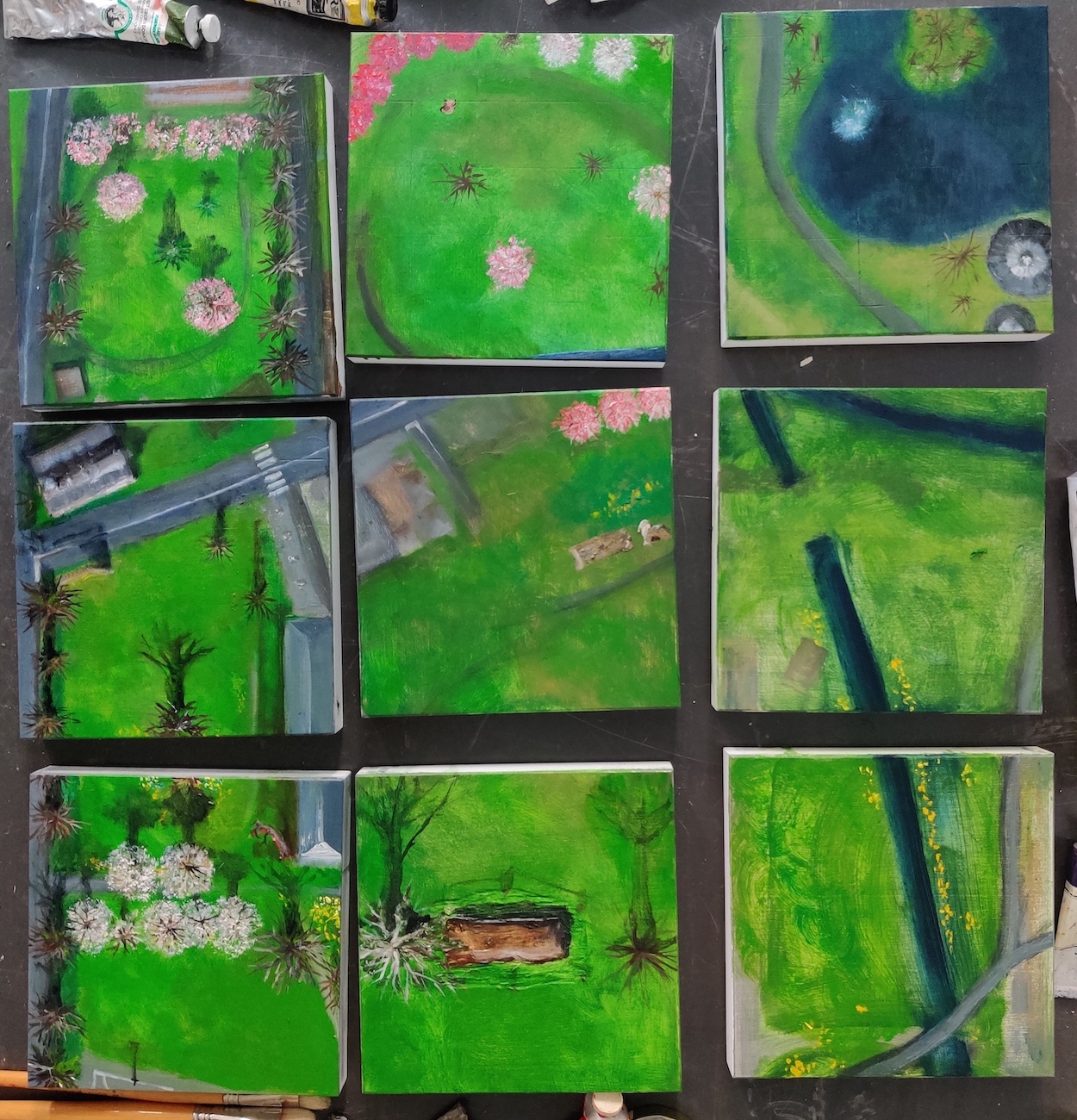
when the world stood still - London Lockdown 2020 (2021)
sketch on 9 lime wood panels 15x15cm each
I am interested in the profound difference between a birds eye view or map of a landscape and how it contextualises our relationship to the world around us. Whereas the traditional European tradition from icons and the Renaissance is window on the world which de-contextualises and abstracts the subject from what lies beyond the frame of the canvas.
In order to visualise humans as a part of nature and in relationship with non-human species I am interested in creating paintings that have a birds eye view.

The Rules
1. Everyday, throw-away, low-value vessels must first be prepared with a ground (surface primer) the
colour of clay.
2. Low-value, throw-away vessels painted to appear like clay must then be decorated using the colours
used by ancient Greek potters.
3. Painted decorative elements of the vessels must be in the style of ancient Greek red-figure or black-
figure ceramics.
4. Representational elements must be translated into contemporary terms.
Performed on 2 November 2012 with the following participants or rule-interpreters:
Anna Bagnoli (sociologist)
Juliette Brown (co-founder terra incognita arts org)
Sarah Campbell (Kettle’s Yard)
Elena Cologni (artist)
David Cross (artist)
David Gill (archaeologist)
Sudeshna Guha (archaeologist)
Charles Hustwick (artist)
Alana Jelinek (artist & rule setter)
Derek Matravers (philosopher)
Christos Tsirogiannis (archaeologist)

1. That the ideas presented by Vickers and Gill in Artful Crafts (1994) are largely correct, and specifically:
2. That equivalents exist in contemporary (Western) cultures of most instances of (existing) ancient Greek material culture.
There is a significant difference between a translation and an equivalent.
3. That ancient Greek ceramics depict three types of contemporary subject. There is a significant difference between a contemporary understanding of Classical cultures and a then- contemporary understanding of a lived culture.

- black = oxidised silver
- red = gold
- deep red = bronze
- white = ivory
Neoclassicism is one type of
translation, as is any diasporic
or anachronistic reference to
the styles associated with
classical Greece.
- Rituals
- Facets of everyday life
- Existing God(s), gods, beliefs

6 site-specific interventions across London and Cambridge
6 oil paintings
(birds eye views of London Stock Exchange, Lloyds of London, London Metals Exchange, BLACCXN)
at 6 intervention sites that have shown exceptional growth in privatisation or links with private sector...
The paintings were left to fate,
to the elements,
to the police,
to security guards,
to art-lovers...
Photographer for all site-specific images - ©Kristian Buus.
creative commons licence
The 6 site-specific interventions were enacted by Alana Jelinek, Juliette Brown and, for the first three, Rachel Anderson. The day's itinerary was available on activist websites and occasionally we were met by audiences who were aware of the interventions. Most often, audiences were casual onlookers, occasionally asking questions.
Audiences could choose to have SMS text alerts to receive image-updates of each successful intervention as they occurred throughout the day.
All paintings were signed on the back with my email address. No one emailed.
Painting of London Stock Exchange boardroom
Painting of London Metal Exchange
In the end, we were filmed by officials at MoD.
Painting of Lloyds of London
(original interior)
Painting of London Stock Exchange computer hub
Painting of BLACCXN headquarters
BLACCXN was invented in 2006 as a fictitious transnational corporation as a way for Alana Jelinek to describe the growing impact of privatisation, trade liberalisation and deregulation
Painting of London Stock Exchange foyer
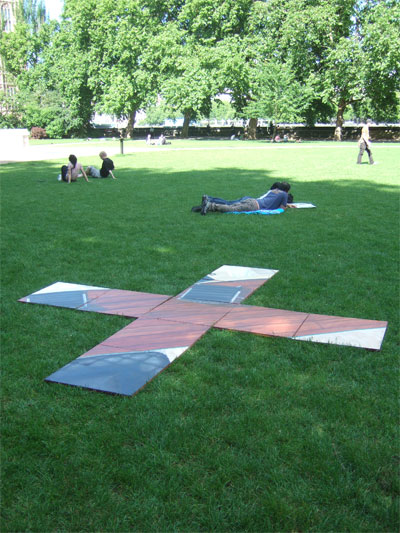
Victoria Tower Gardens, next to Houses of Parliament, with 3x3m oil painting birds eye view of fictional BLACCXN executive offices.
BLACCXN was invented as a grossly outsize transnational corporation (a 'metacorp') in 2006 by alana jelinek in order to describe the growing impact of corporate culture and neoliberalism. This temporary site-specific intervention inspired a later series of interventions called 'capital growth' where the paintings were left to their fate in the chosen public spaces.
'test site' was placed where the imagined, new and innovative third wing of the Houses of Parliament would be built, the House of Corporations
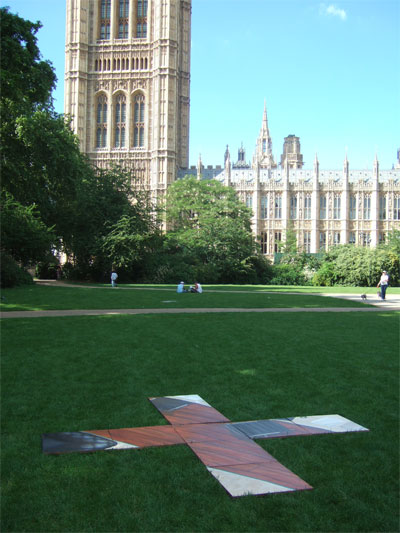
- performances by alana jelinek as BLACCXN PR guru
- Ohm's Law, a novel : the relationship between resistance and power
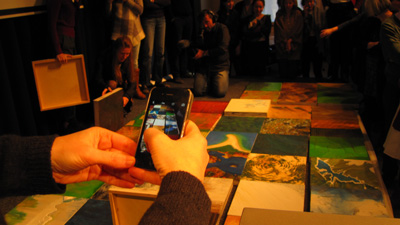
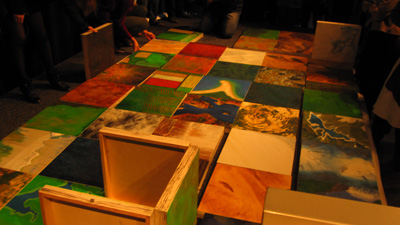
Volkenkunde Museum, Leiden, Netherlands
Available on YouTube
54factorial permutations of Europe with 54/36factorial exclusions
at any one time.
An interactive, participatory oil painting
54 birds eye view landscape paintings can fit into a frame that
includes a maximum of 36 paintings.
Each painting is 60x60cm.

Rules of engagement:
1) The boundary of Europe is marked.
2) Each participant chooses one painting they believe is Europe
3) Each participant places their piece of Europe inside the boundary
4) Players take turns to fill the marked territory of Europe
5)When Europe is filled, players negotiate which pieces belong in Europe and which must come out.
6) The game ends when all players agree on what belongs in Europe
What We Forget (2019)
curated by
< 25 Sept 2016 Europe the Game at
Volkenkunde Museum, Leiden, Netherlands
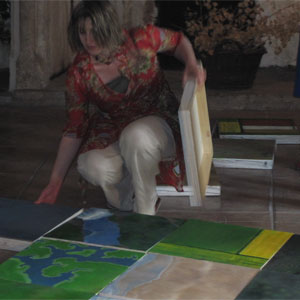

'Earth Critical', Chateau, Alba-La-Romaine, France 2011 (curated by Charles Hustwick)
Beaconsfield Gallery, London, 2004
open mike session

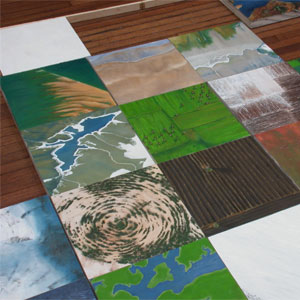
‘Points of View’, Hastings Museum and Art Gallery
2003 (curated by Maud Belleguic and Judith Stewart)


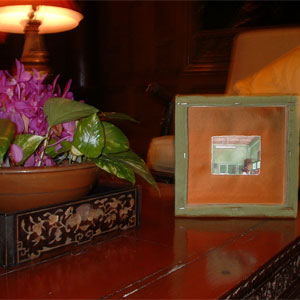
site-specific intervention into Jim Thomson House, Bangkok
‘Inter-weaving Cultures’, Jim Thompson House and Gallery, Bangkok, Thailand
curated by Gridthiya Gaweewong(Th), Sachiko Namba(Jp), Ann Coxon(GB)
24 oil paintings on the back of Jim Thompson™ silk 'canvases' (20x20cm) placed throughout the museum to authentic Thai life. The paintings were of everyday objects (ladders, plastic buckets, mops, park benches, the inside of madrassa) from photos taken by the local Ban Krua community. The paintings served as interventions into the authentic context.
After exhibition, the intention was to give the people who had taken the photos the paintings.
Instead, after 6 weeks on exhibition, the intervention was censored and paintings were moved to the 'neutral' space of the adjacent gallery. No documentation was allowed to be seen or refered to again in any future press. It was as if the original intervention never existed.


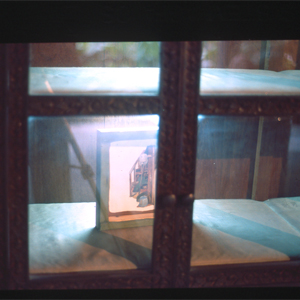
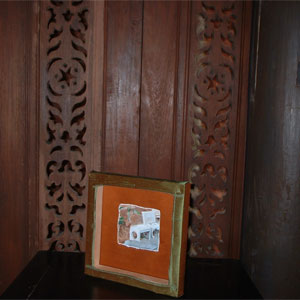
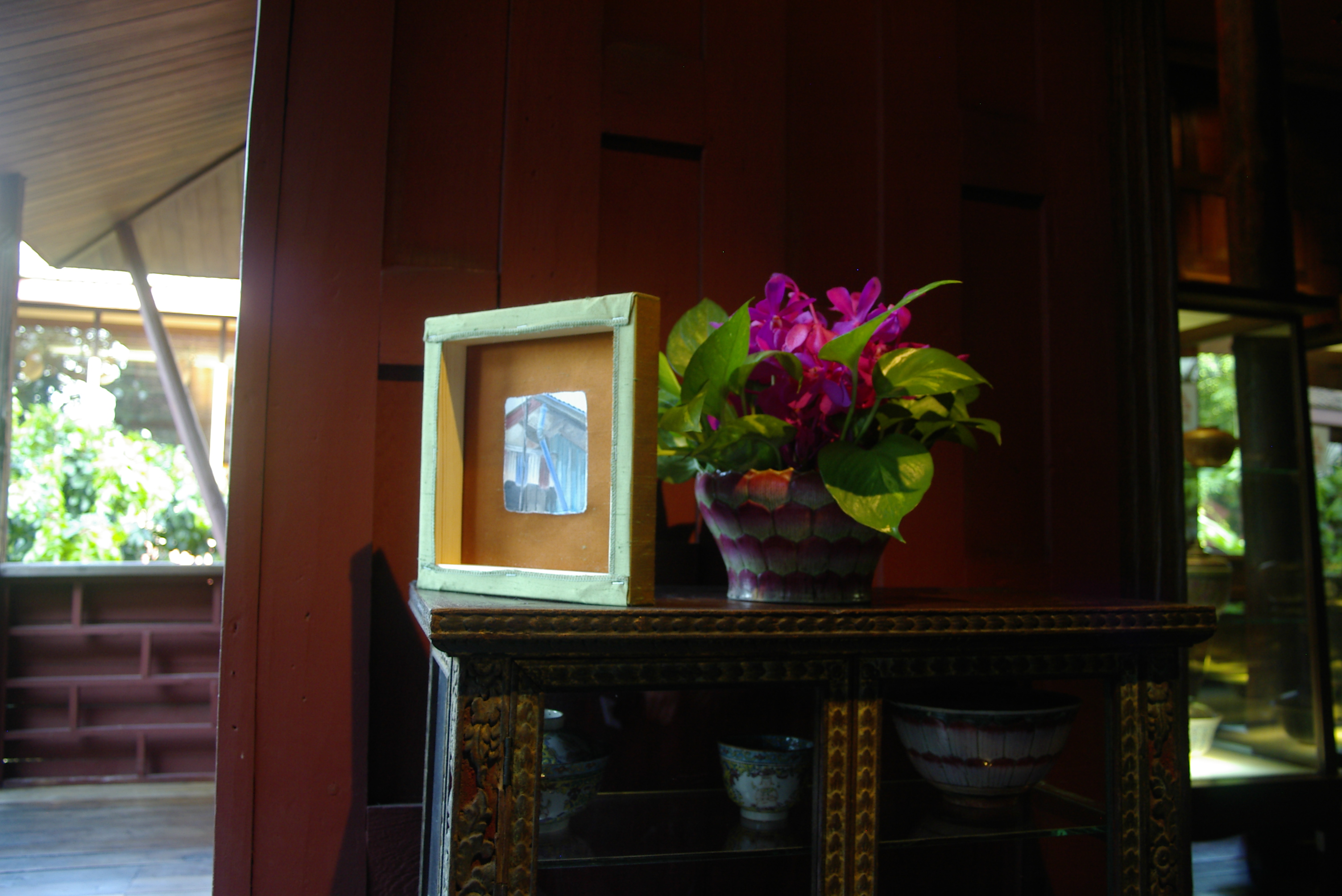
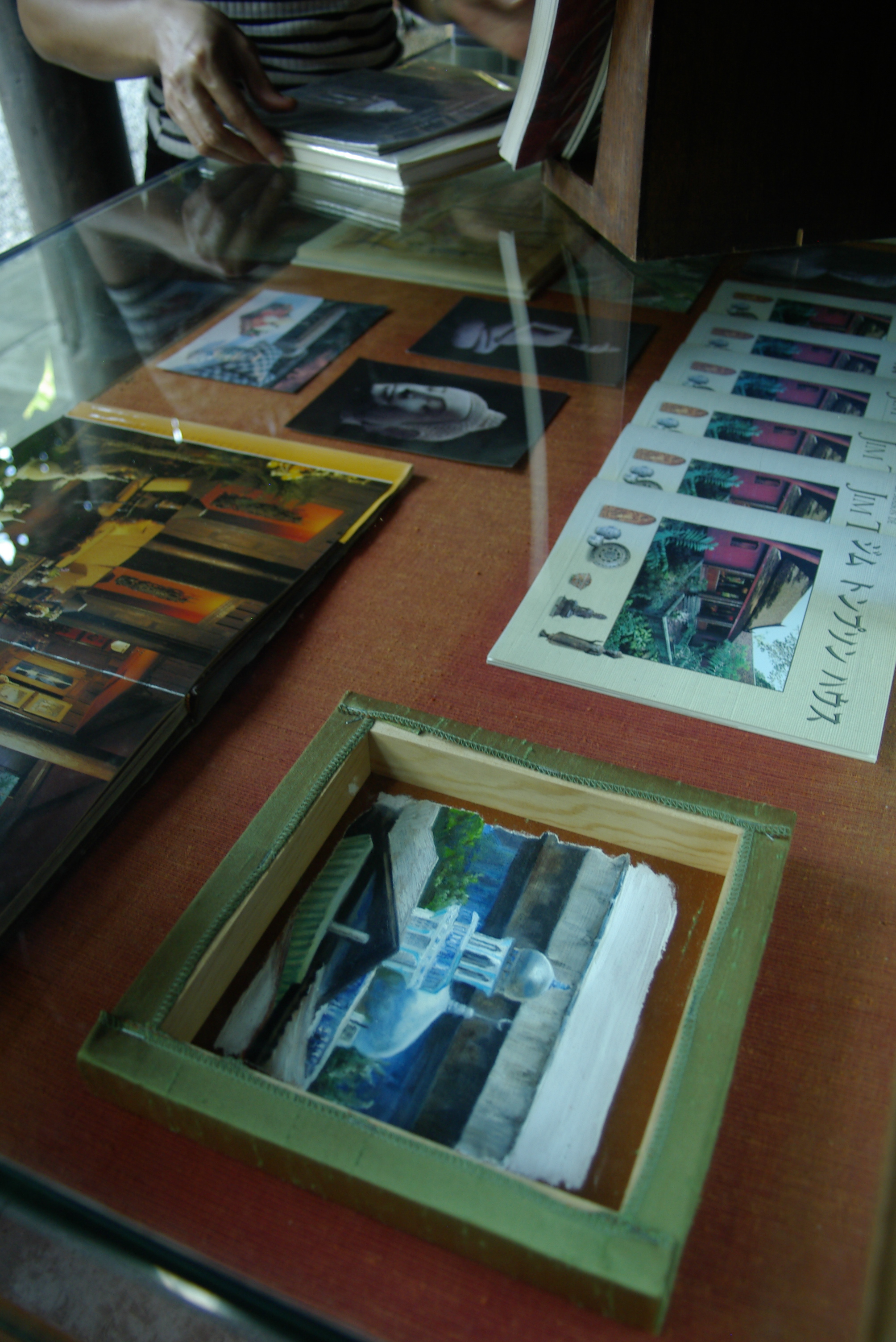
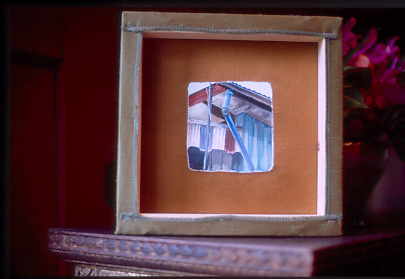
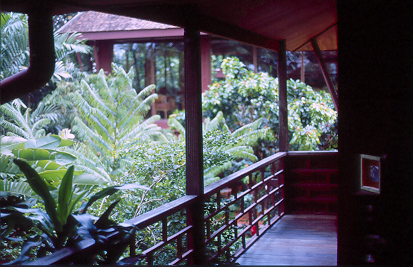
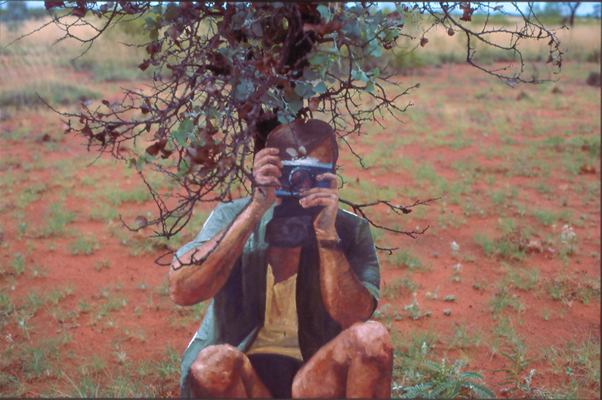
life-sized cut-out oil painting of tourist figure
site-specific intervention left in pilbara region, western australia
farmland opposite aboriginal land

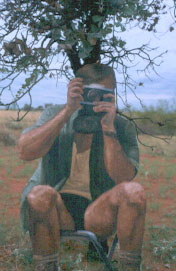

series of 7 life-sized cut-out oil painting of tourist figures
site-specific interventions in various tourist hotspots, including Grizedale as part of 'Naturalized' exhibition (2000), the area around Ambleside and Langdale, Cumbria (2000) and for 'Rich Mix' exhibition (curated by above:below) off Brick Lane, London, E1 (1999)
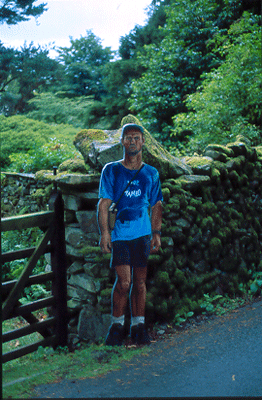
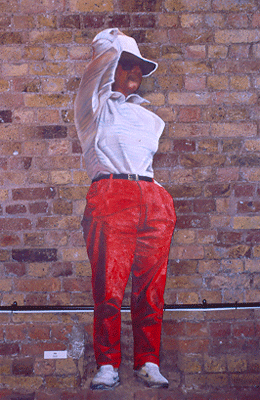
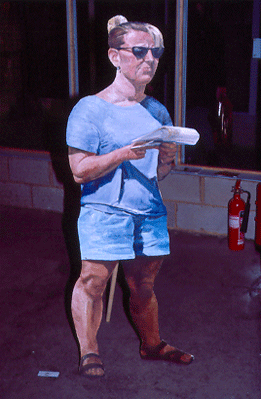

in situ near Brick Lane, London, E1
'Rich Mix' exhibition, 1999 (curated by Above:Below)
left to right:
'colourful', 'exotic', 'mystical'
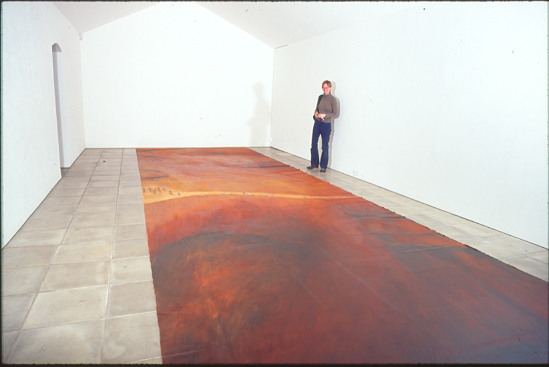
floor-based oil painting of tourist figures climbing uluru as seen from above
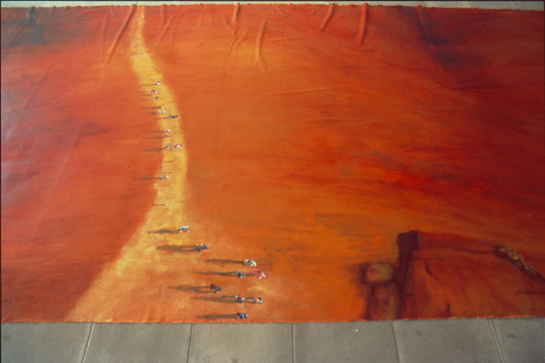
The intention is to force the viewer to negotiate whether to walk on the canvas.
Two other, smaller versions also exist.
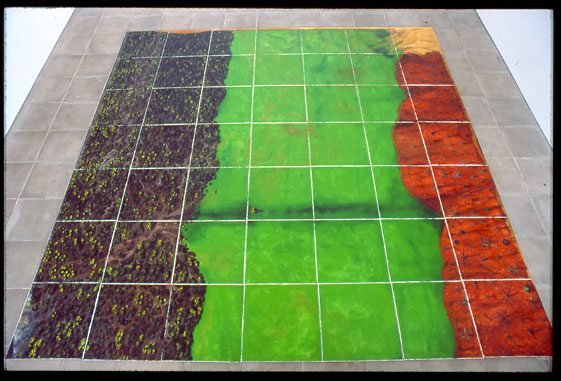
floor-based oil painting of 35 x 60x60cm canvases landscape as seen from above
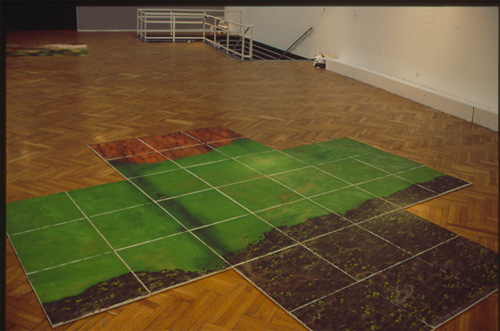
(curated by Marek Wasilew and Martin Parker)
The painting, 56N 1W, was shown, from that exhibition onwards, as x-marks the spot
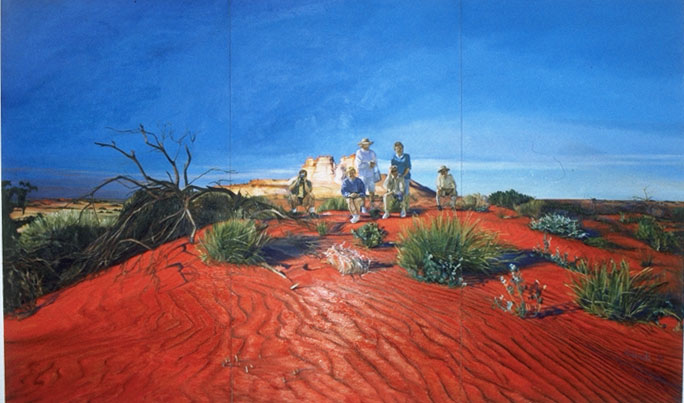
oil on 3 canvases
total dimensions 7x12ft
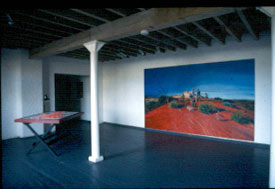
(curated by Alana Jelinek)
Pitshanger Manor and Gallery
Axiom Arts Centre, Cheltenham